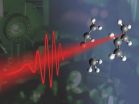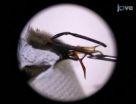(Press-News.org) This press release is available in German.
Chemical reactions occur so quickly that it is completely impossible to observe their progress or to control them using conventional methods. However, new developments in electrical engineering and quantum technology enable us to achieve a more exact understanding and improved control of the behaviour of atoms and molecules. At the TU Vienna, scientists have succeeded in influencing the splitting of large molecules with up to ten atoms using ultra-short laser pulses.
The flash of light which splits molecules
Splitting a molecule is an example of an elemental chemical reaction. The splitting of molecular bonds with a laser pulse is relatively simple. It is much more difficult, however, to influence the splitting of a specific bond in a controlled manner, i.e. to initiate it in a controlled manner or to suppress it. In order to achieve this, the complex processes must be altered at an atomic level. This is carried out at the Institute for Photonics at the TU Vienna using specially-shaped laser pulses, with a duration of only a few femtoseconds. One femtosecond (10-15 seconds) is one millionth of a billionth of a second.
Fast electrons, slow atomic nuclei
One carbon atom has a mass around 22000 times greater than an electron. It is therefore also relatively inert and cannot be moved easily from its position. A laser pulse can therefore change the movement of the small, light electrons much more rapidly than that of the atomic nuclei: One electron can be extracted from the molecule, then reversed using the laser pulse field and collided again with the molecule. During this collision, the electron can subsequently extract a second electron from the molecule. A doubly charged molecule remains, which can then split into two singly charged fragments under certain circumstances.
"Usually, it takes several femtoseconds for the atomic nuclei to reach a sufficient distance from one another and the molecule to split into two pieces", explains Markus Kitzler from the Institute of Photonics at the TU Vienna. The collision of the electron with the molecule only lasts several hundred attoseconds (10-18 seconds). "We therefore have to deal with two separate timescales", explains Kitzler. "Our specially shaped ultra-short laser pulses affect rapidly-moving electrons. The fact that the state of the electrons is changed by the collision also sets the large, slow atomic nuclei into motion."
Using this technique, the TU research team have for the first time been able to show that specific elemental chemical reactions using various hydrocarbon molecules can also be initiated or suppressed in a controlled manner, if the movement of the atomic nuclei are influenced indirectly by the much quicker electrons. The exact shape of the laser pulse is crucial in this process.
The role of electron movement for chemistry
In order to be able to interpret the experimental data correctly and understand what actually happens during these incredibly rapid processes at atomic and electronic level, theoretical calculations and computer simulations are required. This has also been carried out at the TU Vienna - at the Institute for Theoretical Physics, which collaborates with the Institute for Photonics on attosecond projects. Using this method, we can do more than simply observe whether and how a molecule splits. "The experiments and simulations show how the sequence of chemical processes can also be affected in a targeted manner using precise control of the laser pulse", explains Katharina Doblhoff-Dier from the Institute of Theoretical Physics.
INFORMATION:
For more information, please contact:
Dr. Markus Kitzler
Institute for Photonics
Vienna University of Technology
Gußhausstraße 25-29, 1040 Vienna
Tel.: +43-1-58801-38772
Ultra-short laser pulses control chemical processes
How can molecules be split in a controlled manner? A new experiment at the TU Vienna shows how research into ultra-short laser pulses can be combined with chemistry
2012-12-12
ELSE PRESS RELEASES FROM THIS DATE:
Older and younger chronic leukemia patients may need different therapy
2012-12-12
People who develop chronic lymphocytic leukemia (CLL) are typically age 65 and older, but participants in CLL clinical trials are usually several years younger;
The age of CLL patients is not usually considered when determining treatment;
This study suggests that older and younger CLL patients require different therapy.
COLUMBUS, Ohio – Doctors should use different therapies when treating older and younger patients with chronic lymphocytic leukemia, according to a new study led by researchers at the Ohio State University Comprehensive Cancer Center – Arthur G. ...
Researchers shed light on the workings of the body's immune response
2012-12-12
Researchers from Queen Mary, University of London have discovered that two proteins which are believed to play a key role in controlling the body's immune response are found in lower levels in T lymphocytes from patients with multiple sclerosis (MS).
The study found that MS patients' T lymphocytes – types of white blood cells which play an important role in the immune system – were defective at producing the proteins and that this was associated with increased levels of molecules which promote inflammation. The findings are reported in the Journal of Immunology¹.
The ...
Can algae-derived oils support large-scale, low-cost biofuels production?
2012-12-12
New Rochelle, NY, December 12, 2012—ExxonMobil and many other energy companies are investing hundreds of millions of dollars to develop transportation biofuels from renewable resources such as the oil or hydrocarbons produced by microalgae. As global supplies of fossil fuels continue to shrink, biofuels derived from algae represent one promising source of low-cost, scalable renewable energy. The feasibility and economic projections for large-scale biofuels production from microalgae are examined in a Review article and accompanying Commentary published in Disruptive Science ...
Novel test identifies patients most likely to benefit from ALK inhibition therapy
2012-12-12
Philadelphia, PA, December 12, 2012 – Approximately one in 20 patients with non-small cell lung carcinoma (NSCLC) has chromosomal aberrations targeting the anaplastic lymphoma kinase (ALK) gene. This has considerable implications for treatment because these patients are highly responsive to ALK-specific kinase inhibitors such as crizotinib. However, current diagnostic tests have limitations. Researchers have now developed and tested a promising new method for screening ALK fusions in NSCLC. This new diagnostic assay offers a cost-effective and easy-to-perform alternative ...
Frog-in-bucket-of-milk folklore leads to potential new antibiotics
2012-12-12
Following up on an ancient Russian way of keeping milk from going sour — by putting a frog in the bucket of milk — scientists have identified a wealth of new antibiotic substances in the skin of the Russian Brown frog. The study appears in ACS' Journal of Proteome Research.
A. T. Lebedev and colleagues explain that amphibians secrete antimicrobial substances called peptides through their skin. These compounds make up the majority of their skin secretions and act as a first line of defense against bacteria and other microorganisms that thrive in the wet places frogs, toads, ...
A promising clinical trial to reduce the severity of autistic disorders
2012-12-12
This press release is available in French.
Although this therapy is not curative, it nevertheless reduced the autistic disorders' severity in three-quarters of the children. The researchers have filed a request for authorisation to perform a multi-centre European clinical trial in order to determine more precisely the population concerned by this therapy.
Details of this work have been published in the Translational Psychiatry review dated 11 December 2012.
Contribution made by the fundamental research on neuronal chloride
Previous work carried out by the team of ...
New twist on using biomass for perfume, cosmetic, personal care products
2012-12-12
In a new approach for tapping biomass as a sustainable raw material, scientists are reporting use of a Nobel-Prize-winning technology to transform plant "essential oils" — substances with the characteristic fragrance of the plant — into high-value ingredients for sunscreens, perfumes and other personal care products. The report on the approach, which could open up new economic opportunities for tropical countries that grow such plants, appears in the Journal of the American Chemical Society.
Deryn Fogg, Eduardo dos Santos and colleagues explain that breaking down plant ...
New geometries: Researchers create new shapes of artificial microcompartments
2012-12-12
In nature, biological functions are often carried out in tiny protective shells known as microcompartments, structures that provide home to enzymes that convert carbon dioxide into energy in plant cells and to viruses that replicate once they enter the cell.
Most of these shells buckle into an icosahedron shape, forming 20 sides that allow for high interface with their surroundings. But some shells — such as those found in the single-celled Archaea or simple, salt-loving organisms called halophiles —break into triangles, squares, or non-symmetrical geometries. While these ...
Scientists train honey bees to stick out their tongues
2012-12-12
Honey bees are a highly organized, social species, as demonstrated by their complex colonies and the geometric structure of their hives. For hive building, the honey bee strongly relies on its tactile sense, and a new video-article in JoVE (Journal of Visualized Experiments) illustrates a novel tactile conditioning experiment using honey bees. The technique, presented by the lab of Dr. Volker Dürr of Bielefeld University, trains honey bees to stick out their tongues when their antennae touch an object. This procedure allows researchers to analyze how changes in antennal ...
A second ascent of chemistry's Mt. Everest
2012-12-12
In science's equivalent of ascending Mt. Everest, researchers are reporting success in one of the most difficult challenges in synthetic chemistry — a field in which scientists reproduce natural and other substances from jars of chemicals in a lab. The feat, reported in the Journal of the American Chemical Society, involved synthesis of a rare substance with promising in vitro anti-cancer effects found naturally in tiny amounts in a Chinese medicinal herb.
Samuel J. Danishefsky and Feng Peng explain that maoecrystal V occurs naturally in a plant growing in China's Yunnan ...
LAST 30 PRESS RELEASES:
Membrane magic: FAMU-FSU researchers repurpose fuel cells membranes for new applications
UN Member States pledge to increase access to diagnosis and inhaled medicines for the 480 million people living with COPD
Combination therapy shows potential to treat pediatric brain cancer ATRT
Study links seabird nesting to shark turf wars in Hawai‘i
Legal sports betting linked to sharp increases in violent crime, study finds
Breakthrough AI from NYUAD speeds up discovery of life-supporting microbes
New Eva Mayr-Stihl Foundation funding initiative boosts research at University of Freiburg on adaptation of forests to global change
The perfect plastic? Plant-based, fully saltwater degradable, zero microplastics
Bias in data may be blocking AI’s potential to combat antibiotic resistance
Article-level metrics would provide more recognition to most researchers than journal-level metrics
Satiety’s little helper: Protein that supports appetite regulating protein identified
UF dives deep into predicting storm damage with computer models
A stormy ocean voyage yields insights on the global carbon cycle
Scientists identify first non-coding gene that controls cell size
Demonstration of altermagnetism in RuO₂ thin films -- A new magnetic material for the AI era
Penn researchers awarded $25M to conduct trial using smartphones to fight heart disease
PCORI awards funding for new patient-centered healthcare research
Exploring the origins of the universe: 145 low-noise amplifiers complete ALMA telescopes
Empress cicada wings help illuminate molecular structure
Using sound waves to detect helium
Time burden in patients with metastatic breast and ovarian cancer from clinic and home demands
Researchers discover bias in AI models that analyze pathology samples
Scientists ID potential way to prevent brain injuries from triggering Alzheimer's
MASTER 2nd Open Call: Execution period kick-off
Algae for health in food and pharma
Advanced microrobots driven by acoustic and magnetic fields for biomedical applications
Chicago health information leader recognized for raising CPR readiness and blood pressure awareness
The Intimate Animal, a new book from Kinsey Institute Executive Director Dr. Justin Garcia
When blue-collar workers lose union protection, they try self-employment
New video dataset to advance AI for health care
[Press-News.org] Ultra-short laser pulses control chemical processesHow can molecules be split in a controlled manner? A new experiment at the TU Vienna shows how research into ultra-short laser pulses can be combined with chemistry


